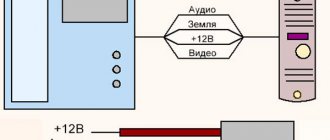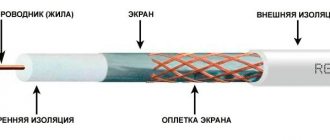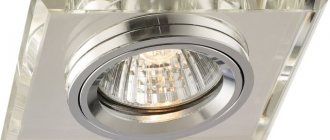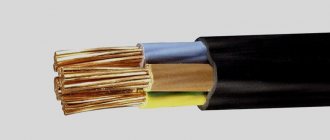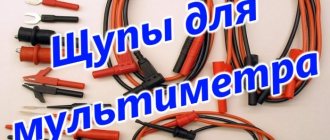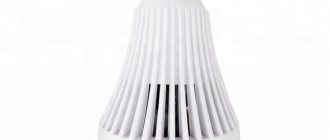Which wires are better to choose - aluminum or copper?
Property owners often have difficulty deciding which wiring is better - copper or aluminum. This question faces private developers and owners of city apartments that are planning major renovations. Not only the operational characteristics of the housing, but also the safety of the owners’ residence depends on the correctness of the decision made. In order not to make a mistake in choosing electrical wiring, you need to understand the pros and cons of each material, find out the common points and fundamental differences.
Benefits of Copper Wiring
In order to make the right choice, it is necessary to compare aluminum with copper. This metal has at least four advantages:
- Good current conductivity, despite the fact that it oxidizes over time.
- Service life up to half a century.
- Good resistance to mechanical damage. Resistant to twisting or bending up to 15 times.
- Copper is easy to use during installation. Manufacturers produce different brands of copper cable, which differ in core structure, technical characteristics and insulation.
In order for the apartment to have high-quality electrical wiring, it is better to purchase a copper cable, because there is only one minus - its price. So, taking into account the pros and cons of copper wiring, we can say that this electrical installation option will be more reliable and its price is justified.
As a last resort, in order to save money, a combination of copper and aluminum can be used, but the connection must be made through terminal blocks of various types in which copper and aluminum do not come into contact. If these wires are connected together, then over time the aluminum is highly oxidized, which leads to heating and burning of the contact. When using conductors in combination, copper is used for sockets, and aluminum is used for lighting. Either copper is used for sockets and lighting equipment, and aluminum is used for distribution boxes from the panel. But it is better to use only copper wire for wiring, just of different cross-sections, taking into account the expected load. In addition, such a requirement is specified in the PUE in Chapter 7.1. clause 7.1.34.
Advantages and disadvantages
Aluminum wiring has the following advantages:
- Small mass. This feature is important when installing power lines, the length of which can reach tens or even hundreds of kilometers.
- Affordability. When choosing a material for wiring, many are guided by the cost of the metal. Aluminum has a correspondingly lower value, which explains the lower price of products made from this metal.
- Resistance to oxidative processes (relevant in the absence of contact with open air).
- Availability of protective film. During operation, a thin coating forms on aluminum wiring, protecting the metal from oxidative processes.
Aluminum also has a number of disadvantages that you need to be aware of:
- High metal resistivity and tendency to heat. For this reason, the use of wires smaller than 16 sq. mm is not allowed (taking into account the requirements of the PUE, 7th edition).
- Loosening of contact connections due to frequent heating when passing a heavy load and subsequent cooling.
- The film that appears on an aluminum wire upon contact with air has poor current conductivity, which creates additional problems at the junction points of cable products.
- Fragility. Aluminum wires break easily, which is especially important when the metal frequently overheats. In practice, the service life of aluminum wiring does not exceed 30 years, after which it must be replaced.
Advantages
This metal is lightweight. This advantage is particularly noticeable in situations where large amounts of aluminum cable need to be used. Thus, the lightness of this metal makes aluminum cable a favorite when laying power lines. It's worth noting that aluminum is a very common metal and costs less than copper. Actually, these two factors became the reason for the use of aluminum wiring in housing construction in the USSR.
Another feature that can be considered as an advantage is corrosion resistance. Although there are some nuances here. The fact is that the surface of aluminum upon contact with air immediately (almost instantly) oxidizes. A film forms on top, which subsequently protects the rest of the wire from oxidation. The downside is the poor ability of the film to conduct current. As a result, problems arise in the passage of current at the cable junctions.
Pros and cons of aluminum cables
Copper wires are superior to aluminum wires in a number of technical characteristics. But cables made of silver metal are still in demand and find their application. This is explained by the advantages that aluminum wiring has:
- low weight and flexibility during installation;
- cheapness;
- oxidation resistance.
Electrical wiring made from aluminum noodles will cost less.
It is not without its drawbacks:
- poor thermal and electrical conductivity;
- high resistance and its dependence on temperature;
- low strength, fragility.
Important! When working with aluminum cables, you must remember their low strength. If you bend the current-carrying wire 3-7 times, it is highly likely to break. If the break is under the cable insulation, it may go unnoticed until the repair is completed.
Rules for using aluminum wiring
Thus, we can come to the conclusion that using aluminum wiring in a residential building is not one of the best options. However, it is quite acceptable if certain requirements are met:
- Use a wire with a cross-section of at least 16 square millimeters.
- Connect individual parts using special clamp contacts. In addition, each of them must be treated with a special lubricant to prevent oxidation. Thanks to this treatment, it is possible to reduce the level of resistance, which will eliminate heating of the wiring.
The superiority of copper over aluminum for wiring
Electrical conductivity
Copper is superior to aluminum in electrical conductivity. The electrical resistivity of copper is 0.017 Ohm*mm 2 /m, while that of aluminum is 0.028 Ohm*mm 2 /m. That is, the electrical conductivity of aluminum is 65% of the electrical conductivity of copper, so for the same load, aluminum wire will have to be taken with a cross-section a “step” higher than copper.
For example, you need to power a load of 5 kW. For it you will need to take either a copper wire with a cross section of 2.5 mm 2, for example, NYM 3x2.5 , or an aluminum wire with a cross section of 4 mm 2. Since aluminum wire is more voluminous, it will take up more space in the cable ducts, and it will require terminals for socket groups that are larger in size than for copper ones. Considering this, copper is more convenient to use for wiring in the house.
Oxidation
Both copper and aluminum oxidize during operation under the influence of air. However, with copper, oxidation occurs much more slowly, and the film itself (greenish coating) is quite easily destroyed, so it conducts current quite well (although the permeability deteriorates slightly). In aluminum, oxidation occurs much faster, and the oxide film itself is very dense and does not conduct current well. Oxidized connections on twists, clamps or terminals most often cause contact burning. You can remove the oxide film with quartz-vaseline lubricant, but it is not so easy to find it in stores, and this requires additional costs and maintenance time.
Mechanical strength
Copper wire is more flexible and durable than aluminum. During the installation process, the cores have to be bent, for example, for connection in distribution boxes and sockets. Copper conductors can withstand repeated bending without damage, but aluminum conductors can only withstand 5 to 10 bends, and then they break.
Aluminum wiring creates particular problems when it is necessary to repair connections in junction boxes - the old aluminum already has microcracks, so with one wrong move the wire may break off and you will have to remove part of the plaster in order to pull out at least a little of the wire.
Thermal conductivity
This parameter characterizes the ability of the conductor to dissipate heat. The higher the thermal conductivity coefficient, the better the metal dissipates heat. Copper has a thermal conductivity coefficient of 389.6 W/m* °C, and aluminum has a coefficient of thermal conductivity of 209.3 W/m* °C. That is, copper dissipates heat almost twice as well as aluminum. This is especially important at connections where the wire gets hottest. At the same load, copper will remove heat twice as fast (or rather, not heat up).
Correct choice of section
Well-made copper wiring can last for many years. Therefore, it is necessary to choose the correct cable cross-section, and for this you need to know what load a particular section can withstand.
The easiest way is to select the cross-section of the copper cable according to the table:
When installing lighting in an apartment or house, you must choose a cable with a cross-section of 1.5 mm2. This cross-section can withstand a load of up to 3 kW, which is quite enough to connect lamps in the room. You can make several main lines from the distribution board, for example, one line for rooms, a second for the kitchen, and a third for the bathroom and corridor. Read about how to divide electrical wiring into groups in our separate publication.
For socket groups, you should choose cores with a cross section of 2.5 mm2, which can withstand a load of up to 4.5 kW. For more powerful electrical appliances, separate lines should be drawn from the panel of a larger cross-section corresponding to the load current of a particular electrical appliance. Such appliances include an electric oven, an electric boiler and a hob. You should also know that to connect electrical appliances with a power of more than 3.5 kW, a regular outlet will not work and you need a power outlet that is designed for a higher load current.
Important point! If there are several electrical wiring lines in one groove (corrugation, pipe, etc.), then they will withstand a different current - less than that specified for 1.5 and 2.5 sq. mm.
Copper wiring
When buying or building a house or apartment, it is advisable to use this type of wiring. However, keep in mind that by replacing the wiring in the apartment you have not yet received a reliable network that can withstand heavy loads. Do not forget that the input cable from the staircase panel to the apartment in old apartments is always made of aluminum. This section should be replaced, because its conductivity is now the weak point of the new network.
Advantages of copper wiring
Comparing the parameters presented below with the parameters of aluminum will allow you to make the right choice in the future. Copper, as a material for electrical wiring, has a number of advantages, which include:
- good conductivity (even after oxidation, the film on the surface does not interfere with the passage of electric current);
- service life reaches 50 years;
- high mechanical strength (the core can easily withstand bending and twisting up to 10-15 times);
- ease of installation (the industry produces several types of wires with different parameters and cores that are convenient to work with).
Rules for connecting copper and aluminum
There are situations when you need to replace only part of the wiring or add (move) several outlets in the apartment. In such a situation, the question arises of how to properly connect wires made of different metals. To avoid increased heating in places where copper and aluminum wiring are combined, it is worth using the following switching methods:
- A “nut” type connection. In this version, the wires are clamped between special plates (there are three in total). First, the plates are unscrewed at the top and bottom, after which a wire is inserted between the middle and top clamps. At the last stage, the product is tightened. The same manipulation is done on the other side.
- Connection using a bolt. This type of fastening is similar to a “nut” with the only difference being that the two wires are combined and placed on one bolt with a washer installed between them. Next, fixation is done using a nut.
- Spring terminals. If the wiring is completely changed, it is better to use WAGO type terminal blocks. Their feature is ease of installation and convenient fastening of wires, thanks to the spring type of clamps. Before using such terminals, it is important to first strip the cable at a distance of 13-15 mm at the edges. After this, the wire is inserted into the hole and secured with small levers. A special lubricant is provided in the middle part of the terminals to prevent metal oxidation.
The use of spring terminals is only permissible in the lighting network. The flow of a large load leads to heating of the terminal block springs, deterioration of the quality of contact and, accordingly, a decrease in conductivity. - Terminal blocks are one of the best options for combining copper or aluminum wires. The product is a strip made of dielectric material with a metal strip and terminal blocks for clamping. During installation, you need to clean the edges of the cable, insert it into the holes and squeeze it well.
The considered connection methods can be used to combine wires made of various metals (not only copper and aluminum). This design guarantees a high level of safety and the ability to avoid potentially dangerous twisting. But it is worth remembering the importance of periodically checking and tightening bolted connections and terminal blocks, because they tend to loosen.
How to choose the right cable for PEU
In the USSR, most of the housing stock was equipped with aluminum power cables; this was the norm, the current standard. This did not mean at all that the country was poor and could not afford to massively use copper in electrical engineering, rather the opposite. It’s just that electrical network designers decided that it was economically advantageous to use aluminum rather than copper.
It must be admitted that at that time the pace of construction was so enormous that the electrical industry was provided with orders for five years in advance. During this period, the well-known Khrushchev buildings were built, in which a significant part of Russians still live. Therefore, the economic effect from such a massive use of aluminum cable products was indeed significant. Today the realities are completely different, and aluminum power cables are not used in new residential buildings, but only copper cable products, which corresponds to clause 7.1.34 of the PUE.
For aluminum power cable, the above section of the PUE left another area of application. Thus, it is preferable for lines supplying distribution networks to be made with aluminum current cores, in projects where their design cross-section will be 16 mm2 or higher. In addition, a large area of current receivers, which relates to the maintenance of electrical equipment of objects: pumping, fan and heater electrical installations can power cables with aluminum current cores with a cross-section of more than 2.5 mm2.
To summarize the above, we can confidently say that the existing standards clearly separate the areas of application of aluminum and copper power cables, taking into account all their technical and cost characteristics. However, today designers, architects, and electrical engineers working on electrical power supply projects must overcome the bias towards the use of aluminum products, especially since this technology has made great strides in the quality of this metal. This approach will make it possible to use economical aluminum during installation, which will provide significant savings throughout the country.
Important installation guidelines
We will provide several recommendations that can help you when installing electrical wiring yourself:
- When installing electrical wiring, you need to think in advance about a circuit with the required number of outlets for your home. It is important to plan not only their number, but also where it is best to install them for comfortable use. With the installation of copper cable, you need to take into account the increased load on the electrical wiring.
- Make sure that the electrical wiring is equipped with grounding.
- A residual current device and circuit breakers must also be present in the electrical circuit. They will protect the network from power surges, fire and electric shock.
- It is necessary to correctly take into account the cross-section of the conductors and correctly select all network elements so that they work reliably and can withstand the appropriate load.
- If there is a lot of humidity in the room, it is necessary to protect the wire with corrugation. Other elements of the electrical network must also be moisture resistant.
- When purchasing, make sure that the cable has the appropriate documents. If you are sold a cable of poor quality, the wiring may not work for a long time.
Copper conductors can last quite a long time and are a reliable material for electrical wiring. If you are interested in the difference between aluminum and copper conductors, we recommend watching the following video:
These are the key points regarding the installation of copper conductor.
Don’t be afraid to carry out the installation yourself: the main thing is to think through an action plan in advance and carefully select all the elements and materials of the electrical network.
